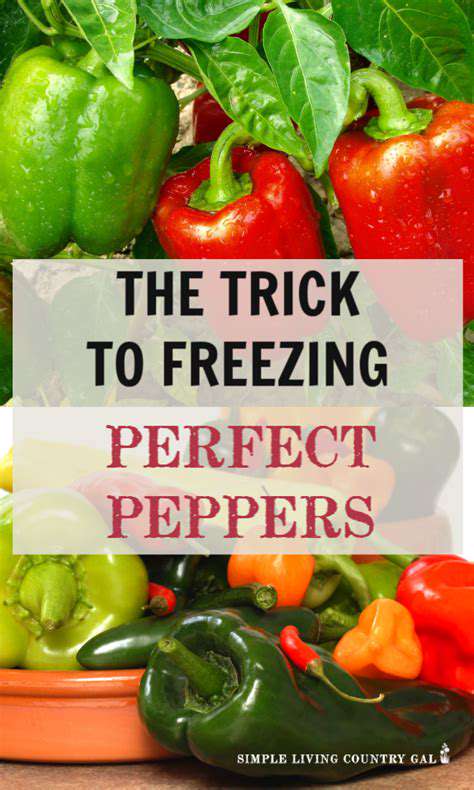How to Store Sweet Peppers: Keep Them Fresh
Understanding the Importance of Refrigeration
Refrigeration stands as the cornerstone of preserving sweet peppers effectively. By creating a cool, stable environment, the natural ripening cycle slows dramatically. This not only preserves the pepper's signature crunch and vibrant taste but also creates an inhospitable environment for harmful microorganisms. The right refrigeration approach can nearly double the shelf life of fresh peppers compared to room temperature storage.
Proper Temperature Control for Optimal Storage
The ideal refrigeration zone for sweet peppers falls between 34-38°F (1-3°C). This narrow range represents a delicate balance - temperatures dipping below may cause cell damage leading to softness, while anything above accelerates decay. Modern refrigerators often have crisper drawers specifically designed to maintain this perfect microclimate for produce. Investing in a refrigerator thermometer can help verify your appliance maintains these critical temperatures consistently.
Choosing the Right Storage Container
Storage containers make a dramatic difference in preservation outcomes. While plastic bags seem convenient, they often trap ethylene gas and moisture - the twin enemies of fresh produce. Instead, consider these superior options:- Perforated plastic bags (create small holes if needed)- Paper bags (excellent moisture regulation)- Breathable produce storage containersThese alternatives allow just enough air circulation without dehydrating the peppers.
Preventing Over-Ripening and Softness
The battle against over-ripening begins the moment peppers are harvested. Even in refrigeration, these vegetables continue very slow metabolic activity. Separating peppers from ethylene-producing fruits like apples or tomatoes can dramatically slow this process. For peak results, store different colored peppers separately as they ripen at varying rates - greens last longest, followed by yellows, then reds.
Minimizing Moisture Build-Up
Excess moisture creates the perfect breeding ground for mold. A simple yet effective technique involves lining storage containers with dry paper towels to absorb condensation. Change these towels every few days as needed. Some experts recommend wrapping each pepper individually in paper towels before grouping them in containers for maximum protection against humidity.
Handling and Preparation Before Storage
Proper pre-storage handling follows three critical steps:1. Gentle washing (avoid soaking)2. Thorough drying (pat with clean towels)3. Careful inspection (remove any damaged areas)This protocol removes surface bacteria while preventing water from becoming trapped in crevices where decay begins.
Storage Time Considerations
Storage duration varies significantly by initial ripeness:- Green peppers: 1-2 weeks- Yellow/orange peppers: 5-7 days- Red peppers: 3-5 daysRotate stored peppers regularly, using those showing any soft spots first to prevent spreading issues to others in the batch.
Freezing Sweet Peppers for Extended Storage

Freezing Sweet Peppers for Extended Enjoyment
Freezing transforms seasonal abundance into year-round culinary possibilities. When properly executed, this method captures approximately 90% of the pepper's original nutrients and flavor compounds. Flash freezing individual pieces on a tray before bagging prevents clumping and allows portion-controlled usage later. This technique proves especially valuable for gardeners with bumper crops or shoppers finding seasonal sales.
Preparing Peppers for Freezing
Preparation quality directly impacts frozen results. After coring and deseeding, consider these cutting options based on intended use:- Diced (for stir-fries, omelets)- Strips (fajitas, sandwiches)- Halves (stuffed pepper recipes)- Whole (for roasting after thawing)Uniform cuts ensure even freezing and consistent cooking later.
Blanching for Optimal Preservation
The blanching process requires precision:1. Bring water to rolling boil2. Submerge peppers for 2-3 minutes3. Shock in ice water for equal timeThis stops enzyme activity without cooking the peppers. Adding a teaspoon of lemon juice to the blanching water helps preserve vibrant colors. Proper blanching makes the difference between mediocre and excellent frozen pepper quality.
Freezing Methods and Storage
For professional-level results:- Use vacuum sealing for longest storage (10-12 months)- Heavy-duty freezer bags work well (6-8 months)- Layer peppers with parchment between them- Remove air using the water displacement methodLabel with contents, preparation date, and planned use-by date for best organization.
Thawing and Using Frozen Peppers
Frozen peppers perform best when:- Added directly to cooked dishes (no thawing needed)- Used in soups, stews, or sauces- Incorporated into baked dishesFor raw applications, quick-thaw in a colander under cold running water preserves texture better than other methods. The slight softening that occurs makes them unsuitable for fresh salads but perfect for cooked preparations.
An anti-inflammatory diet focuses on consuming foods that naturally combat systemic inflammation. Chronic inflammation underlies many modern health challenges, and dietary choices significantly influence inflammatory pathways. Colorful vegetables like sweet peppers feature prominently in such eating plans due to their high antioxidant content.

- Baking for Beginners: Easy Recipes to Master
- Instant Pot Basics: Quick & Easy Pressure Cooker Meals
- Discovering Brazilian Feijoada: A Hearty Stew
- High Protein Breakfast Ideas: Fuel Your Day
- How to Store Avocados: Ripening and Storing
- Buying Organic Produce: Is It Worth the Cost?
- Exploring Spanish Tapas Desserts: Churros and Flan
- Kitchen Decor Ideas: Stylish and Functional
- Cooking for Special Diets: Allergies and Intolerances
- Simple Beef Recipes: Versatile and Delicious
- High Protein Smoothies: Power Up Your Day
- Unveiling Japanese Street Food: Takoyaki and Okonomiyaki